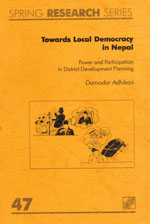Every 12 months, members of the Kabre district council meet to consider their plan for the year ahead. At three meetings from 2000 to 2002 they approved the draft blueprint unanimously, changing only the sites of two of the 96 projects approved in 2000.
"The plan seems to be unanimously agreed upon as an outcome of a nearly perfect planning exercise. However, this is not all true," writes scholar Damodar Adhikari in a new book.
What really happens is that the nearly 200 councillors arrive on meeting day one and are handed a proposal totalling more than 150 pages. "Reading such a huge planning document in a very short time is nearly impossible. Most district council members are clueless and every member's personal as well as territorial interests dominate the meeting," Adhikari concludes in Towards Local Democracy in Nepal: Power and Participation in District Development Planning
Time constraints and personal interests are only two of countless shortcomings of a system that after 1990's people's movement was designed to replace the Panchayat's charade of local governance with real grassroots democracy, based on the Local Bodies Act (1991) and the current highly-praised Local Self-Governance Act (1999). But reality has failed to match the promise of the LSGA, argues Adhikari.
Towards Local Democracy in Nepal was written as a PhD thesis so it's necessary to flip past pages of theory and explanations of methodology before reaching the story of the workings of Kabre's government. Even then, the tale is tarnished by a lack of quotations and anecdotes. (It would have been great to hear citizens who participated in planning meetings at the settlement and ward levels comment on whether the approved plan reflected their concerns, for instance). That lack of 'colour' is disappointing because with terms such as "full" and "inclusive" democracy zipping through the Nepali air, the timing is perfect for this book. The author sets out to situate Kabre in the context of a theory that pits 'rationality power' generated by a participatory planning process against the 'discretionary power' wielded by decision makers.
It's David versus Goliath: "A number of day-to-day planning and development related activities in the DDC are carried out based on what is commonly known as Tok Adesh (ad hoc instruction) of political representatives, the DDC president in particular.(these) decisions undermine the participatory spirit of the district plan," writes Adhikari.
In fact, he assigns only a small part of the responsibility for local democracy's failures to district level governments. Decentralisation, Adhikari argues, has been short-changed-and at times short-circuited-by a legal framework that's fuzzy on the sharing of powers between levels of government, inadequate fiscal transfers from the centre, lack of accountability and, especially, the reluctance of elected representatives at all levels to give up any power.
Can it be fixed? The task is monumental, but Adhikari offers a number of suggestions, including: educate local officials about decentralisation, local democracy and planning immediately after they're elected; transfer line agencies working locally to DDCs; replace indirect local election to the DDCs with direct election; and establish a local civil service system to 'make the members of the local bureaucracy responsible and accountable to the local government.'

Towards Local Democracy in Nepal: Power and Participation in District Development Planning
Damodar Adhikari
SPRING Centre, Faculty of Spatial Planning, Universitat Dortmund
2006
304pp, plus bibliography and appendices
ISBN 3-934525-47-4


